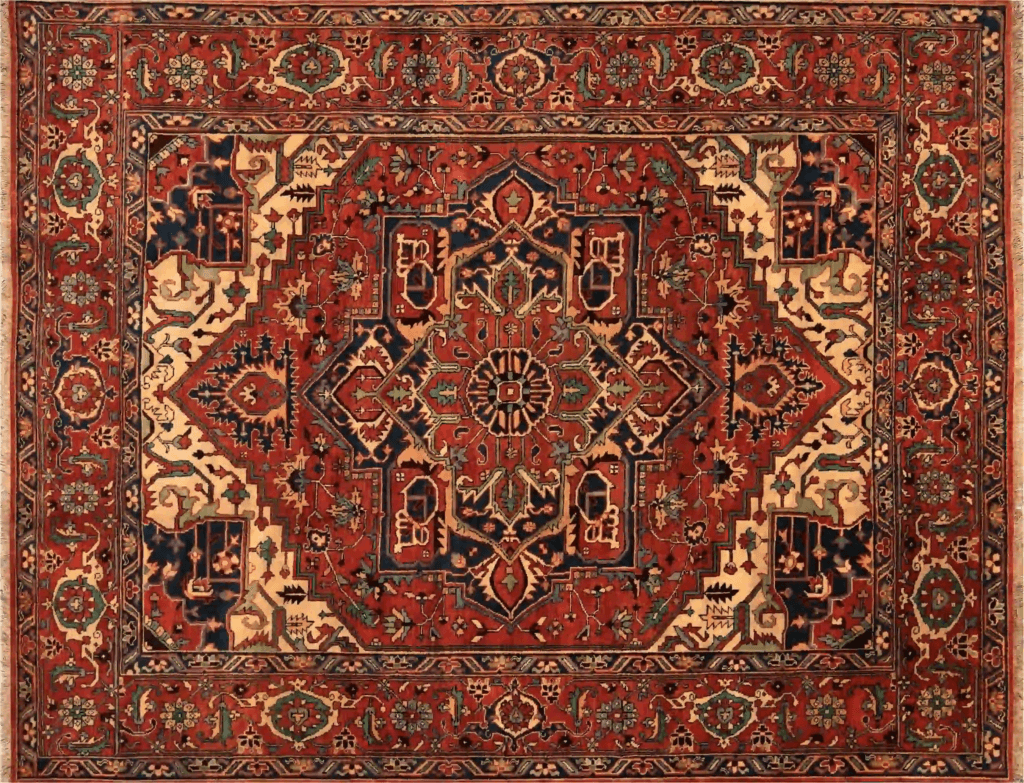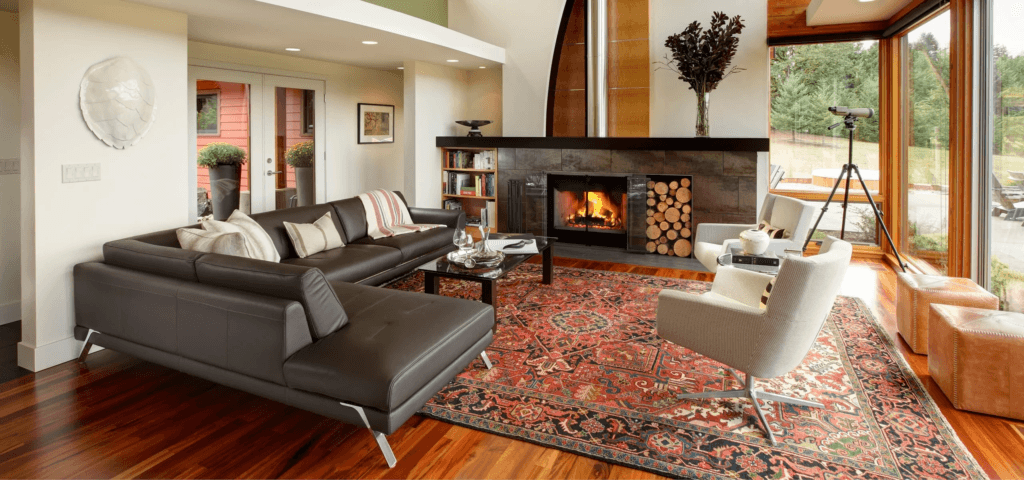A Guide to Valuing the Artistry of Durable Ancient Heriz Rugs
Ancient Persian rugs charm any room, whether an apartment living room with classic furniture or a five-star hotel lounge. Perhaps there’s no more incredible testament to the longevity of an ancient Persian rug than its ubiquity. Heriz rugs (pronounced “ha-rees”) can complete or entirely transform a space thanks to their bold and captivating designs. They complement many decorating styles and are known for their resilience and durability. What makes Heriz rugs so magnificent? Here’s everything you didn’t know and needed to know about the art of these unique rugs.
Heriz rugs – also known as “village rugs” – are perhaps the most famous style of traditional Persian rugs. These rugs originated in the farming villages of northwestern Persia, known for their centuries-old rug weaving techniques. Heriz has become the widely accepted term for all three dozen villages that wove rugs in this style, east of the city centre of Tabriz, in northwestern Persia. The region’s traditional methods have remained unchanged and are passed down from the old times to the new, a testament to an influential and respected artistic process.

- Pattern and Design
Heriz rugs are instantly recognizable by their large central medallion and distinctive corners with designs that feature striking geometric shapes with symmetrical motifs, angular motifs, straight lines and shapes.
The hallmark of the classic Heriz rug is a robust central medallion. The fascination lies in the color combinations made from plants, sharp and saturated, woven into large geometric floral designs. Dyed wool in shades of red and pink made from madder root and shades of blue, derived from indigo and incorporated into rectilinear designs rather than the curvilinear ones found in more formal Persian rugs. This is the beauty of Heriz carpets: they are more rustic interpretations of the classic city carpets influenced by the arts of the Safavid dynasty of the 16th and 17th centuries. The result is a relaxed and welcoming rug.
- Materials
The materials used to make Heriz rugs are responsible for their durability. Traditional Persian Heriz rugs come from near Mount Sabalan, a mountain rich in copper deposits. As the sheep graze, they drink the mountain’s copper-infused water, which strengthens and improves the quality of their wool.
Using special vegetable dyes, the wool yarn is tinted with the conventional rust reds, navy blues, golds, greens and amber that make Heriz Persian rugs so distinctive. Unlike chemical dyes, these colors soften over time, increasing the beauty and depth of the rug. Weavers typically make rugs using a resilient wool yarn over a strong cotton weave.
- Weaving technique
Artisans weave the rugs on looms with hand-tied symmetrical knots that differ from the asymmetrical knotting technique found in Persian rugs. With around 200 knots per square centimeter, this technique creates dense, short hair.
- Immersion in the river
Heriz rugs obtain their beautiful and distinctive rust-red hue from an immersion method in the local river that alters the natural dye and changes its tones. Once the rug is ready, the weavers place them in local copper-infused water, which helps produce the unique and vibrant rust-red color exclusive to authentic Heriz rugs.
How to make the most of the art of an antique Heriz rug in your home
The bold geometric patterns and vibrant colors of Heriz rugs make them a striking decorative piece in both modern and traditional environments. Make the most of any space with these three decorating ideas to style a Heriz Persian rug in any room.

- Select the correct size
A rug that is too small loses its value while a rug that is too large for a room may look awkward. Find the right size for your Heriz rug with these tips:
Select a rug size that is at least 6 to 8 inches wider than the furniture, especially if you place sofas, chairs, or tables on top of the rug. Leave at least a foot of space between the edge of the rug and the wall, unless any furniture is directly against the wall.
Smaller rugs—less than 8 feet by 10 feet in most cases—can be placed in larger rooms as long as you layer them on top of other rugs or carefully place them as part of a smaller section of the room, as in a nook or in a separate living room.
An interior designer can guide you through this process if you need additional help. Whether you use the rug as a starting point for your design or incorporate it later in the process, it’s a good idea to start with a room-sized Heriz—9′ x 14′ or larger—so that all of your furniture can stay. on top of the rug, creating a defined space of comfort for you, your family and your guests.
- Consider it a focal point
How you incorporate a Heriz into a room’s decor depends on whether you are starting from scratch or trying to incorporate existing furniture into the room. If you are starting from scratch, it is always recommended and easiest to start with the carpet.
Heriz rugs are, without a doubt, statement pieces that dramatically – and beautifully – alter the feel of a room. Consider elements of your design, from bold hues to ornate motifs, and find pieces for the rest of the room’s decor that complement the energy of the space.
When adding new upholstered pieces, they should be in neutral colors so they don’t compete with the rich colors and patterns of the Heriz.
If you already have a room full of furniture, after placing the Heriz in the room, take photos of the space from various angles. Through the images, it should be clear to you if one of your upholstered pieces does not match the rug; in this case, you may need to reupholster it (in neutral colors), move it to another room, or replace it.
Wooden furniture, geometric lamps, rust-colored fabrics and vintage-style frames are ways to bring the room together, forming a visual theme with your Heriz rug at the center.
- Play with patterns and colors
Mixing patterns and colors is a unique way to infuse any space with personality. Following a Heriz’s distinct patterns and palettes is the perfect idea to start with. Heriz rugs offer a multitude of ideas for color choices because they contain so many colors – rust, ochre, blue, ivory and beige to name a few.
The key to successfully mixing patterns and prints is to stick to a unique color palette. When this color combination matches those on the carpet, you can’t go wrong.
The walls of the room can even be a dark color if you want to create a more dramatic and strong atmosphere, as long as it is the same color as the rug. Try to stay away from colors that don’t pair well with Heriz’s rich colors, like lavender, pinks, yellows, and greens.
Keep an eye on the scale of the pattern too. Other designs you can mix and match include stripes, florals, and other geometric prints. Be careful though – too many patterns or textures in a space can make the room look busy and tiring and overshadow the beauty of your Heriz rug.

Figalli Oriental Rugs
We do not sell rugs. We bring rare works of art to your home in the form of rugs.
Our services
You are Protected
Copyright © 2023 Figalli Oriental Rugs, All rights reserved. Desenvolvido por Agência DLB – Agência de Marketing Digital em Porto Alegre
